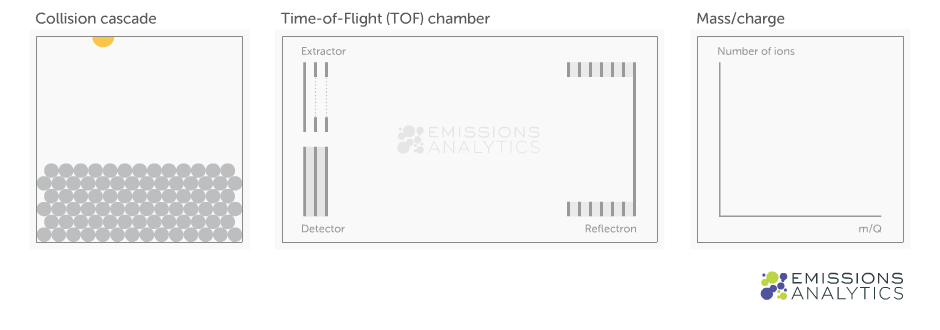Importance of Time-of-Flight mass spectrometry
Time-of-Flight (TOF) is a mass analyser that utilises an electric field to accelerate generated ions through the same electrical potential, and then measures the time each ion takes to reach the detector. If the ions all have the same charge, their kinetic energies will be identical and, therefore, each ion’s velocity will depend only on its mass. This means that lighter ions reach the detector first, while heavier ions take longer.
The particular strengths of TOF are as follows:
In one pulse, the entire mass range can be analysed with high resolution and high sensitivity.
Higher resolutions compared to unit mass resolving power of quadrupole mass filters enhance the separation and identification capabilities.
Having the entire spectrum at hand rapidly provides much more data in less time, hence more analytical speed and sensitivity in complex mixtures.
Concept of Time-of-Flight (TOF) measurement. The extractor gives all ions the same kinetic energy. They travel into a field free region (the TOF chamber). A reflectron increases resolution. The detector counts how many ions arrive as a function of time. All ions are measured in each microsecond-length flight. Thousands of flights are added together to report a single measurement.
| Time-of-Flight Mass Analyser | Quadrupole Mass Analyser | |
| Acquisition | Can monitor all mass to charge (m/z) simultaneously | Only monitors individual m/z in a sequence |
| Speed | Fast scan speed | Good scan speed |
| Resolution | High resolution | Low resolution |
| Sensitivity | High sensitivity on full scan | Lower sensitivity on full scan but high sensitivity on selected ion monitoring (SIM) |
| Mass Accuracy | High mass accuracy | Poor mass accuracy |
| Mass Range | Unlimited mass range | Limited mass range |
The advantages of time-of-flight mass analysers compared to quadrupole measurement are clear. Samples can be measured faster and with no spectral skewing. For the same mass range, a TOF analyser will measure each ion more sensitively. Since all ions are included in each simultaneous full-spectrum scan, no important information is missed or discarded. Finally, the much higher resolving power of TOF allows the separation of isobars and the determination of elemental formula. A TOF-MS system, however, is capable of acquisition rates up to 500 spectra per second independent of mass range, making it an excellent choice as an MS detector for high-speed GC and GCxGC applications.

